Is Organic Food Really Better?
Is Organic Food Really Better?
In a most recent study published in the British Journal of Nutrition (2014), titled “Higher Antioxidant and Lower Cadmium Concentrations and Lower Incidence of Pesticide Residues in Organically Grown Crops: a Systematic Literature Review and Meta-Analyses,” authors Baranski, Srednicka-Tober, Volakakis et al. carried out meta-analyses based on 343 peer-reviewed publications that indicate statistically significant and meaningful differences in composition between organic and non-organic crops.
Baranski et al. found that concentrations of a range of antioxidants, such as polyphenolics, were substantially higher in organic crops as quantified in their phenolic acids, flavanones, stilbenes, flavones, flavonols and anthocyanins being an estimated 19%, 69%, 28%, 26%, 50% and 51% higher respectively.
Baranski, Srednicka-Tober, Volakakis et al. (2014) Higher antioxidant and lower cadmium concentrations and lower incidence of pesticide residues in organically grown crops: a systematic literature review and meta-analyses. British Journal of Nutrition: 112. 794-811 (read the whole article)
Clinical Notes:
Our Therapeutic Food Supplements are wild crafted or organic. In our analysis of Phyto Power which contains three species of wild-crafted rosehips, 4 species of wild-crafted blueberries, and 4 species of wild-crafted dandelions, the polyphenolic phyto chemicals were dramatically more densely packed into the plants than in conventionally farmed rosehip, blueberry and dandelion.
The following charts – an excerpt from our 2012 article that you can read in full here – show the difference in phytonutrient between of the Phyto Power wild-crafted rosehip and conventionally grown dog rosehip from Europe:
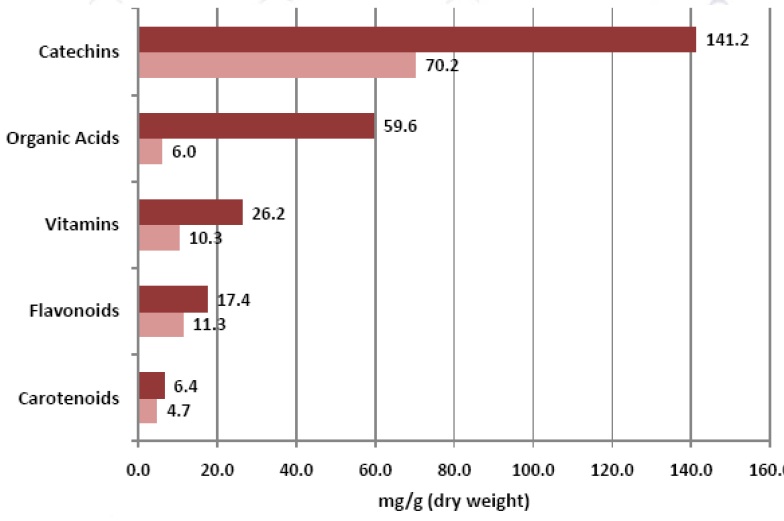 When it comes to rosehip, the European Dog Rose (Rosa canina L.) has been considered to be the most potent and is used as the standard by which others are measured.
When it comes to rosehip, the European Dog Rose (Rosa canina L.) has been considered to be the most potent and is used as the standard by which others are measured.
As you can see to the right here in the bar graph nutrient comparison of the wild crafted Alaska Rosehip to the Dog Rose, the Alaskan produce is much more potent (with the darker red being the Alaskan and the lighter red the Dog Rose).
When we look at the catechins specifically the difference is 2 to 1 in favor of the Alaskan Rosehip, with the Alaskan Rosehip containing in mg/g:
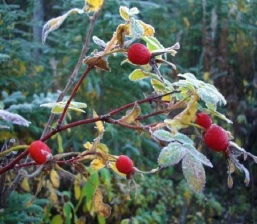 72.05 catechin
72.05 catechin- 67.50 epicatechin
- 0.93 gallocatechin
- 0.45 epicatechin gallate
- 0.25 catechin gallate
While the Dog Rose contains in mg/g:
- 35.70 catechin
- 33.70 epicatechin
- 0.86 gallocatechin
- 0.15 epicatechin gallate
- 0.02 catechin gallate.
The total in mg/g is 141.20 for the Alaska Rose and 70.20 for the Dog Rose. The rosehip has everyone of the catechins except EGCG which you find in tea.
Regarding the Organic Acids comparison in mg/g:
Alaska Rosehip
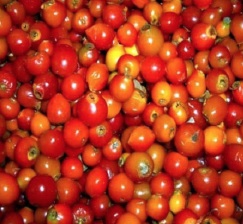 48.30 Ellagic acid
48.30 Ellagic acid- 7.85 Gallic acid
- 1.54 p-Coumaric acid
- 0.97 Protocatachuic acid
- 0.38 Caffeic acid
- 0.30 Chlorogenic acid
- 0.22 Salicylic acid
- 0.06 Ferulic acid
Dog Rosehip
- 5.25 Ellagic acid
- 0.14 Gallic acid
- 0.16 p-Coumaric acid
- 0.18 Protocatachuic acid
- 0.00 Caffeic acid
- 0.05 Chlorogenic acid
- 0.14 Salicylic acid
- 0.09 Ferulic acid
The total difference in mg/g between the Alaskan and the Dog is 59.62 to 6.01.
Let’s compare the difference in Flavonoids, again in mg/g:
Alaska Rosehip
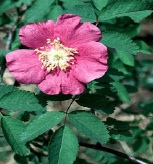 10.50 Quercetin
10.50 Quercetin- 3.03 Hyperoside
- 1.62 Kaempferol
- 0.78 Isoquercitin
- 0.56 Phloridzin
- 0.42 Isohamnetin
- 0.26 Naringenin
- 0.16 Rutin
- 0.06 Nothofagin
- 0.02 Luteolin
- 0.02 Biochanin A
Dog Rosehip
- 1.05 Quercitin
- 4.30 Hyperoside
- 0.00 Kaempferol
- 3.51 Isoquercitin
- 1.49 Phloridzin
- 0.00 Isorhamnetin
- 0.15 Naringenin
- 0.67 Rutin
- 0.07 Nothofagin
- 0.01 Luteolin
- 0.00 Biochanin A
In summary there is 17.40 mg/g of the Alaska to 11.27 mg/g of the Dog.
Now let’s compare their quantitative differences in mg/g of the Vitamin content:
Alaska
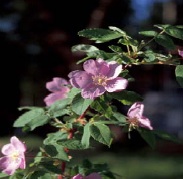 25.00 Vitamin C
25.00 Vitamin C- 1.09 Vitamin B3
- 0.08 Vitamin B2
- 0.03 Vitamin B1
- 0.01 Vitamin B6
Dog RoseHip
- 10.00 Vitamin C
- 0.19 Vitamin B3
- 0.11 Vitamin B2
- 0.01 Vitamins B1
- 0.00 Vitaminl B6
The total are 26.21 mg/g of the Alaskan Rosehip to 10.31 mg/g of the Dog Rose.
Regarding the Carotenoids (Lycopene, b-Carotene, Lutein and Zeaxanthin) in mg/g:
Alaska Rosehip
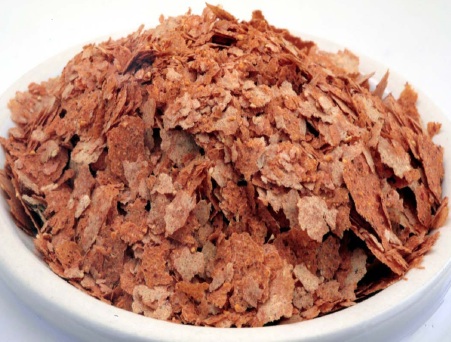 4.89 Lycopene
4.89 Lycopene- 1.15 b-Carotene
- 0.21 Lutein
- 0.17 Zeaxanthin
Dog Rose
- 2.98 Lycopene
- 1.53 b-Carotene
- 0.00 lutein
- 0.19 Zeaxanthin
The total 6.42 Alaskan to 4.70 Dog.
You can see in the above picture the refractance dried rosehip flakes that we mill into a powder for encapsulation. In the coming weeks we will look at the important active ingredients within the Alaskan blueberry and the dandelion. But, as you can see with our rosehip, this produce is quite simply loaded with actives.
Now in regards to the second question, is there enough quantity in a capsule to make a therapeutic difference, the answer is absolutely. Just consuming two capsule a day would be the equivalent of eating 6 whole rosehips (pericarp and all), a small handful of blueberries and a salad made up entirely of dandelion.
Keeping our focus on the rosehip, the pericarp (the petal base) and the seeds are very bitter and astringent, but they are literally packed with catechins, and consuming a small amount can go a long ways therapeutically. According to Norman Hollenberg, professor of medicine at Harvard Medical School, epicatechin can reduce the risk of four of the major health problems: stroke, heart failure, cancer and diabetes. He believes that epicatechin should be considered essential to the diet and thus classified as a vitamin (Science Daily March 12, 2007; Int. J. Med. Sci. 2007, 4:53-58).
So as you can see there is so much to consider therapeutically here. In regards to the rosehip, not are there catachins, but there’s the caratenoids, there’s ellagic acid, there’s Vitamin C , and so much more. We love our Phyto Power, consider taking one to two capsules daily.
Why the differences?
When plants are grown organically or grown in the wilds of nature they don’t have the protection of herbicides and pesticides. Therefore they create lots of polyphenolic phytochemicals which function as antioxidants, transcription molecules, antimicrobials to protect themselves from harmful pests and pathogens. When we eat these nutrient rich plants we can utilize and receive the benefits of these powerful molecules to protect our own body’s cells and functioning, and support our own immune systems.
When dosing with PhytoPower take two capsules daily. That is like eating six wild rosehips with seeds and all, a small handful of anthocyanin rich blueberries and a small cup of dandelion salad with their roots, leave and seeds.


Farmscape
Farmscape is the largest urban farming venture in California. Our mission is to connect city dwellers with fresh, organic produce through a network of urban farms, while creating living wage jobs for the new generation of farmers.
©2005 – 2014 BioImmersion Inc. All Rights Reserved